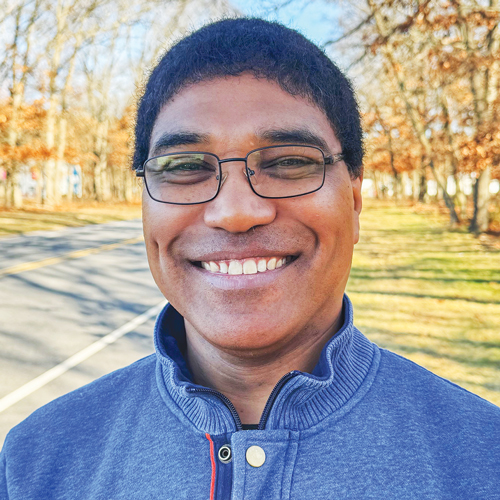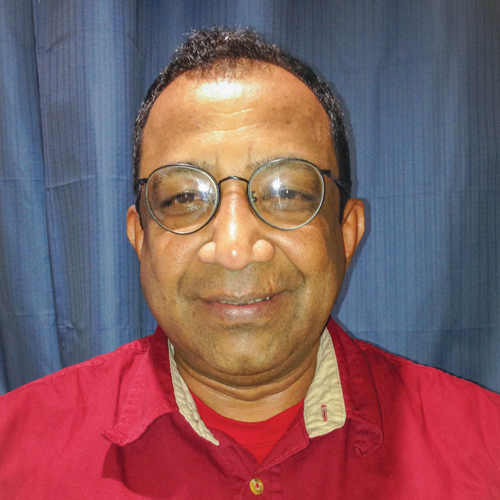The World Tribune spoke with two nuclear physicists who are also SGI-USA members, Samuel Kim, of Los Alamos, New Mexico, and Shelley Boon, of Berkeley, California, on how Buddhism impacts their work.
World Tribune: Thank you for speaking with us. Could you share a bit about your background?

Samuel Kim: I’m currently a post-doctoral nuclear physicist conducting research at a national laboratory.
This lab is where the atomic bomb was developed. While it’s true that research toward developing nuclear weapons continues here, various efforts are being made to explore other applications of nuclear physics.
For example, we are making progress with utilizing an aspect of radiation’s power to target and eradicate cancer cells precisely. Specifically, my research is aimed at ensuring that the healthy cells are not affected by radiation during the treatment.

Shelley Boon: I worked as a quantum and nuclear physicist. To this day, I can’t disclose the work I did.
I admit that I enjoyed the pay and prestige my work brought. I even visited Nagasaki and Hiroshima and shed tears learning of the horrors of the atomic bombs. Still, I was deep in research and didn’t fully comprehend the impact of my work.
Then, I was introduced to Buddhism. Shortly after, I encountered an essay by Ikeda Sensei on nuclear abolition. The following week, I walked away from my job, comfortable life and any potential work in those labs, and have since taught or pursued other research.
WT: Nuclear physics is often associated with nuclear weapons and harmful radioactivity. In what ways can the field benefit society?
Sam: Nuclear physics originated from a desire to understand the universe. In that effort, we discovered applications of that knowledge, similar to how understanding gravity led to airplanes.
At one extreme are weapons. At the other end are MRIs, research to treat cancer and develop better space suits. And there may be more beneficial applications we have yet to discover.
Due to its nature, much of nuclear physics research is related to national security concerns. But everyday things like the internet or GPS also originated from military research. It’s hard to say what our research in nuclear physics will lead to as we conduct it.
But as we learn in Buddhism, what’s important is our perspective and purpose in tandem with this knowledge. Laws of physics don’t change, and this technology will continue to exist. Whether it’s used positively or negatively depends on people’s fundamental life conditions—on human revolution. Toward that end, we should communicate clearly the good and bad aspects of nuclear technology so that the public understands it for what it truly is.
Shelley: I believe nuclear power is another example. Because of its association with nuclear weapons and incidents such as the ones in Fukushima and Chernobyl, there is a lot of fear around it.
Of course, it has its challenges with maintenance, outdated facilities and disposal of nuclear waste. But the technology is there today to construct significantly safer, more controlled systems. It has potential, alongside solar, wind and wave power, to help humanity move away from fossil fuels.
Specifically, the recent breakthrough with nuclear fusion is promising. Nuclear fission—what we’ve been applying—splits the atomic nucleus. This generates tremendous energy, but its byproducts are quite unstable and radioactive. Nuclear fusion combines two atomic nuclei. While it takes tremendous energy to make fusion happen, it generates even more energy than fission and its byproducts are generally more stable.
But again, much of the focus goes to the destructive properties of these discoveries—to threaten other countries or protect ourselves—when we could guide this technology to provide energy for countries in need or to combat global warming.
WT: As an individual in this field, how are you guiding this research toward good?
Sam: For years, as a nuclear physicist, I wondered if there was a way for me to directly contribute to people. This current research, I feel, is a response to my prayer. It’s my hope that what we discover will help cancer patients and the people who have to handle radioactive materials. And I hope that this value-creating knowledge can be shared so that we can collectively improve this treatment.
Unfortunately, the highly competitive nature of research science can sometimes lead to self-serving behaviors among scientists. From a Buddhist perspective, this resembles the world of asuras. Every day, I strive to be an example of humanism in my interactions with my colleagues. I share Buddhism with others and chant for their happiness. Ultimately, it’s our human revolution that will be the fundamental solution to this issue.
Shelley: I don’t know how we can change the entire nuclear industry. But I think back to how I was once an employee at a lab. These are people doing the research and making these decisions. It comes back to changing people.
Maybe I was shortsighted to quit. I often wonder if I could’ve impacted things more from within those labs. But I participate in organizations like the Union of Concerned Scientists to inform people about Ikeda Sensei’s peace proposals. That’s something I could do, and maybe there are other ways I have yet to explore.
But the main way is sharing Buddhism. A nuclear chain reaction is the power source behind the sun and nuclear weapons. In the same way, shakubuku is like a peaceful nuclear chain reaction—where the atoms in our body vibrate toward peace, and that energy passes on from one person to another—reaching all humanity as envisioned by Nichiren Daishonin and our eternal mentors.
You are reading {{ meterCount }} of {{ meterMax }} free premium articles

